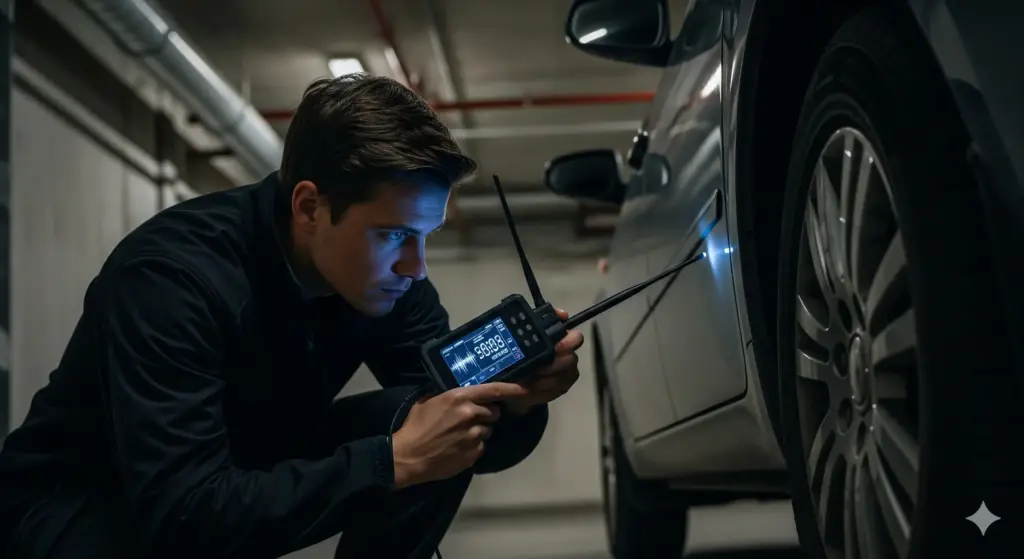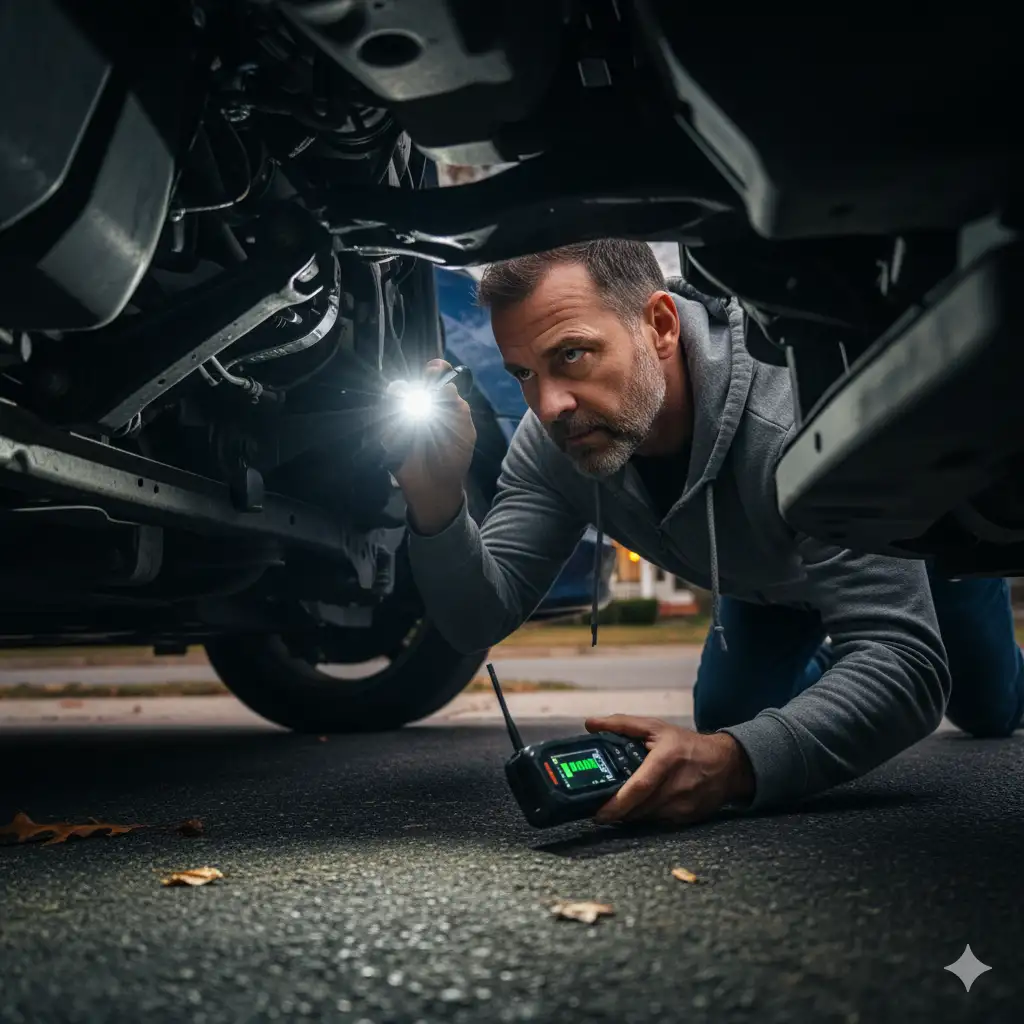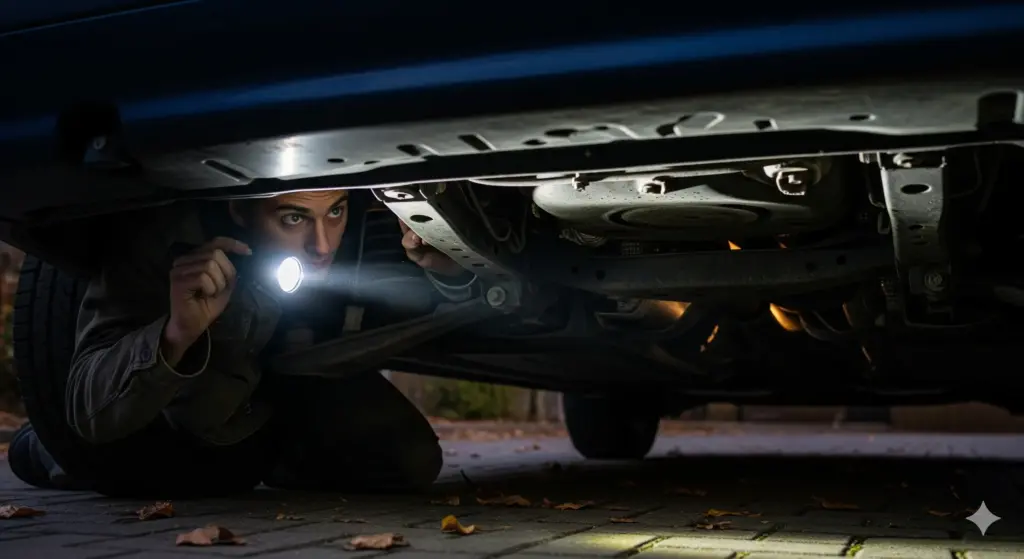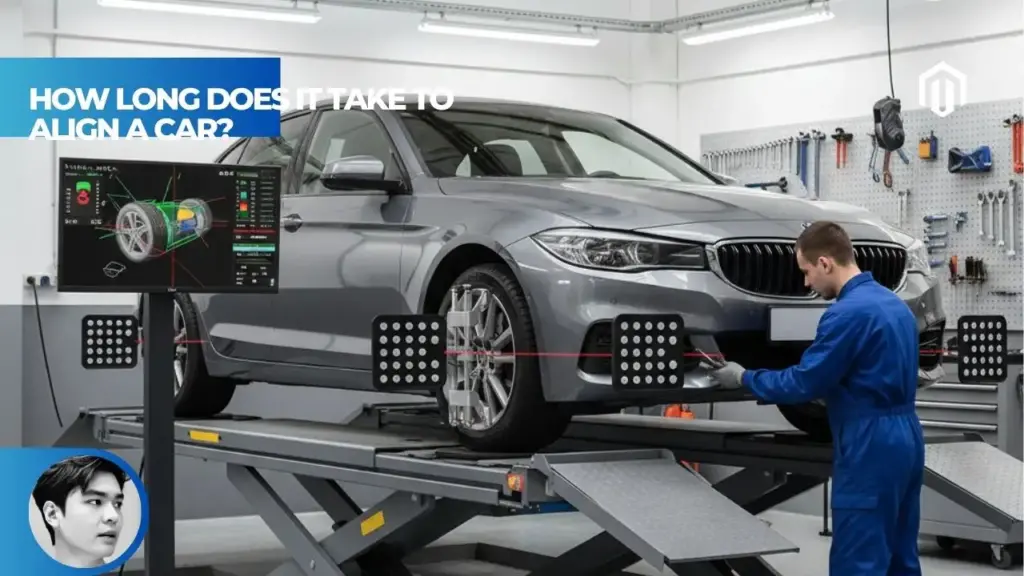You may also like:
- 【Explained】How to Get Rid of Ants in Your Car?
- 【Explained】Can Audi Track My Stolen Car? Requirements, Process, and Cost
- 【Explained】How to Get Pot Smell Out of a Car? Your Complete DIY Guide
- 【Explained】Why Does My Audi Car Key’s Red Light Blink But the Car Does Not Open? (5 Fixes)
- 【Explained】Can a Police Officer Search Your Car Without a Warrant? (The 5 Legal Exceptions)
To find a hidden tracking device on your car, systematically check common hiding spots including wheel wells, undercarriage, OBD-II port, and use an RF detector ($50-$875) to locate active transmitters within 30 feet[1]. Installing tracking devices without consent is illegal in most states, punishable by up to 5 years in prison and $5,000 in fines – if you suspect unauthorized tracking, document everything and contact law enforcement immediately[2].

Understanding Modern Vehicle Tracking Threats
Vehicle tracking has evolved beyond simple GPS devices. Today’s trackers range from $20 Bluetooth tags like AirTags to sophisticated hardwired GPS units drawing power from your car’s electrical system[3]. Professional bug sweep services report finding tracking devices in 30-40% of vehicles they inspect, with Bluetooth trackers and GPS units being the most common[4].
The motivation behind unauthorized tracking varies widely. Stalkers use these devices for harassment, private investigators monitor subjects illegally, and even dealerships sometimes leave “lot management” trackers active after sale[5]. Understanding the threat helps you search more effectively – a jealous ex-partner likely placed a magnetic tracker for quick installation, while a sophisticated adversary might hardwire a device deep within your vehicle’s systems.
Types of Tracking Devices to Look For
GPS Trackers
Professional GPS trackers transmit location data via cellular networks, providing real-time tracking accurate to within 6 feet[3]. These devices cost $100-$500 and require monthly service fees. Battery-powered models last 2-4 weeks, while hardwired versions draw continuous power from your vehicle[6]. They’re typically black or gray boxes measuring 2-4 inches, often with small antennas or LED indicators.
Bluetooth Trackers (AirTags, Tile, SmartTags)
Apple AirTags and similar Bluetooth trackers have become the stalker’s tool of choice due to their $29 price point and year-long battery life[7]. These coin-sized devices leverage millions of nearby smartphones to report location, making them effective even without cellular service[7]. AirTags emit an audible chirp after 8-24 hours of separation from their owner, but stalkers often disable the speaker[8].
OBD-II Port Trackers
These plug directly into your vehicle’s diagnostic port (usually under the steering wheel), drawing power and sometimes accessing vehicle data[6]. Insurance companies legitimately use these for usage-based policies, but unauthorized versions cost as little as $25 online[9]. They’re the easiest to find but also provide the most comprehensive tracking data.
Physical Inspection: Where to Search
Exterior Locations
Start your search with the vehicle’s undercarriage – the most common hiding spot for magnetic trackers[1]. Use a mechanic’s mirror and flashlight to inspect frame rails, behind bumpers, and inside wheel wells[6]. Trackers here are usually enclosed in weatherproof cases and attached with powerful magnets.
Run your hands along the inside edges of wheel wells where visual inspection is difficult[1]. Check the spare tire compartment and any exterior compartments. Professional investigators often place devices near metal surfaces for better signal transmission while maintaining concealment[10].
Interior Hot Spots
Remove floor mats and check beneath seats – sliding seats forward and backward to expose hidden areas[6]. Inspect the OBD-II port for unfamiliar devices or spliced wires[9]. Open the glove compartment, center console, and door pockets, feeling for devices tucked behind panels[1].
Dashboard areas require careful inspection. Remove lower panels if possible, looking for loose wires or components that don’t match your vehicle’s original equipment[6]. Check sun visors, overhead consoles, and between seats where devices can be wedged[10].
Engine Compartment
Though heat and metal can interfere with signals, trackers are sometimes hidden near the battery, behind the radiator, or inside air filter housings[6]. Understanding your car’s components helps identify foreign objects. Be cautious not to disturb critical engine components during inspection.

Using Detection Equipment
RF Detectors and Bug Sweepers
Radio frequency detectors identify active transmissions from GPS and cellular trackers. Entry-level models cost $50-$200, while professional-grade equipment ranges from $875-$1,400[11]. The detection process requires methodical scanning:
Set your detector to medium sensitivity to avoid false positives from legitimate electronics[1]. Start with the engine off and all electronics disabled, then slowly sweep the vehicle exterior[12]. Pay attention to signal strength indicators – stronger signals indicate proximity to the transmitter[1].
Professional bug sweepers detect frequencies from 1MHz to 12GHz, covering GPS, cellular, and Bluetooth transmissions[13]. Some advanced models include non-linear junction detectors (NLJD) that find electronics even when powered off[13].
Smartphone Detection Apps
For AirTags specifically, iPhone users receive automatic notifications when an unknown AirTag travels with them[8]. Android users must download Apple’s “Tracker Detect” app, which requires manual scanning[7]. The app shows any AirTags separated from their owner for more than 10 minutes.
These apps have significant limitations. They only detect specific brands, require manual activation on Android, and won’t find GPS trackers or modified devices[14]. Professional detection remains more reliable for comprehensive sweeps.
Professional Detection Services
When to Hire Professionals
Consider professional detection if you’re facing credible threats, involved in sensitive legal matters, or initial searches yield nothing despite strong suspicions[15]. Professionals use spectrum analyzers, thermal imaging, and specialized knowledge to find sophisticated devices[13].
Warning signs that warrant professional help include: unexpected battery drain, new wiring you didn’t install, cellular interference near your vehicle, or if you’ve already found one device (stalkers often place multiple trackers)[10].
Cost of Professional Bug Sweeps
| Service Type | Price Range | Duration | What’s Included |
|---|---|---|---|
| Basic Vehicle Sweep | $500-$1,500 | 1 hour | Visual inspection, RF detection |
| Comprehensive Sweep | $1,500-$2,500 | 2-3 hours | NLJD scanning, thermal imaging |
| High-Security Sweep | $2,500-$5,000 | Half day | Complete disassembly, cyber analysis |
| Emergency/Rush Service | +50% premium | Varies | Same-day response |
Most services include interior/exterior inspection, RF scanning up to 12GHz, and motion-activated bug detection[4]. Higher-tier services add computer system analysis and warranty against missed devices.
Legal Implications and Protection
State and Federal Laws
Installing tracking devices without consent violates federal law and state statutes in all 50 states[2]. California and Texas impose particularly strict penalties, with violations classified as felonies[17]. Florida Statute 784.048(5) makes unauthorized tracking a third-degree felony punishable by 5 years imprisonment[2].
Exceptions exist for vehicle owners tracking their own property, parents monitoring minor children, and law enforcement with warrants[18]. Employers can track company vehicles but must notify employees in most states[17].
Evidence Documentation
If you discover a tracking device, don’t immediately remove it. Photograph its location, serial numbers, and any identifying marks[10]. Understanding vehicle tracking systems helps distinguish legitimate from illegal devices. Document the discovery with video if possible, showing the device’s concealment and your vehicle’s license plate for context.
Contact law enforcement before removing the device – they may want to investigate it for fingerprints or trace its purchase[10]. Many trackers have internal logs showing installation dates and location history that could identify the perpetrator.
Prevention Strategies
Regular inspections every 2-3 months deter tracker placement and ensure early detection[6]. Vary your parking locations and routines when possible – predictable patterns make tracking easier[10]. Install a steering wheel lock or car alarm with tilt sensors that activate when someone accesses your vehicle’s underside.
For high-risk individuals, consider these additional measures: Use a GPS jammer (legal for personal use in private property only), park in secured garages when possible, and maintain awareness of who has access to your vehicle[10]. Some security professionals recommend “sanitizing” rental cars and recently serviced vehicles, as these present tracking opportunities.

Key Takeaways
- Check common hiding spots: wheel wells, undercarriage, OBD-II port, and under seats where 60% of trackers are found
- Use RF detectors ($50-$875) to find active GPS and cellular transmitters within 30 feet
- AirTags and Bluetooth trackers cost only $29 but can be detected with free smartphone apps
- Professional detection services cost $500-$2,500 and find devices in 30-40% of suspected vehicles
- Unauthorized tracking is a felony in most states, punishable by up to 5 years in prison
- Document any devices found before removal for potential legal action
Decision Path / Next Steps
Immediate Actions:
- Perform visual inspection of common hiding spots (30 minutes)
- Check OBD-II port for plug-in devices
- Download detection apps (iPhone: Built-in, Android: Tracker Detect)
- Listen for AirTag chirping if separated from owner 8+ hours
If You Find a Device:
- DO NOT immediately remove it
- Photograph location, serial numbers, and placement
- Contact law enforcement for evidence preservation
- Consider restraining order if stalking is suspected
Professional Help Needed When:
- High-risk situation (domestic violence, custody dispute)
- Initial search yields nothing despite strong suspicions
- Multiple devices found
- Device appears professionally installed or hardwired
Prevention Schedule:
- Inspect vehicle every 2-3 months
- Check after service appointments or valet parking
- Immediate inspection if battery drains unexpectedly
- Verify removal of dealer tracking devices at purchase
Frequently Asked Questions
How can I tell if an AirTag is tracking my car?
What’s the most common place to hide a GPS tracker?
Can a GPS tracker drain my car battery?
How much does it cost to have my car checked for trackers?
Is it illegal to remove a tracker I found on my car?
Do tracker detection apps really work?
Can dealerships track cars after purchase?
Dealerships must disclose and remove inventory tracking devices at sale, though some “forget” to deactivate them[5]. Buy-here-pay-here lots often install starter interrupt devices that include GPS tracking, which should be disclosed in your contract[6]. Request written confirmation that all tracking devices have been removed.
References
- BrickHouse Security. (2025). GPS Detector | Tracking Device & GPS Tracker Detector. https://www.brickhousesecurity.com/gps-detectors/
- Robert Malove Law. (2019). Understanding Tracking Devices and their Consequences. https://www.robertmalovelaw.com/understanding-tracking-devices-consequences/
- LandAirSea. (2024). GPS Trackers vs. Apple AirTag: Key Differences Explained. https://www.landairsea.com/blogs/gps-trackers-vs-apple-airtag/
- OzSpy. (2025). Car Bug Sweep | GPS Tracker & AirTag Detection. https://www.ozspy.com.au/car-bug-sweep/
- YouTube. (2025). How to Find the Hidden GPS Tracker in Your Car and Remove It. https://www.youtube.com/watch?v=find-hidden-gps-tracker
- GPS Technologies. (2025). How to Find a Hidden GPS Tracking Device on Your Car. https://www.gpstechnologies.com/find-hidden-gps-tracking-device-car/
- PCMag. (2025). AirTag vs. Tile: What’s the Best Bluetooth Tracker? https://www.pcmag.com/reviews/apple-airtag
- ExpressVPN. (2025). AirTag stalking explained: Signs, cases, and how to protect. https://www.expressvpn.com/blog/airtag-stalking-explained/
- Reddit. (2024). My dad put a gps tracker in my mom’s car. How do we find it. https://www.reddit.com/r/RBI/comments/gps-tracker-find/
- Southern Recon Agency. (2025). How to Find a Hidden GPS Tracker on Your Car. https://www.srecon.com/how-to-find-tracker-on-car/
- SpyGadgets. (2009). Bug & RF Detectors: Professional Countermeasures Devices. https://www.spygadgets.com/counter-surveillance/bug-rf-detectors/
- BrickHouse Security. (2024). How to Find a GPS Tracker Using a Bug Detector. https://www.brickhousesecurity.com/how-to-find-gps-tracker-bug-detector/
- Howe Law Firm. (2025). Airplane Bug Sweep Services Cost. https://www.howelawfirm.com/airplane-bug-sweep-services-cost/
- YouTube. (2025). Can I Find a Hidden GPS Tracker on My Car Using Just an App? https://www.youtube.com/watch?v=gps-tracker-app-test
- Southern Recon. (2025). How Much Does a Bug Sweep Cost? https://www.srecon.com/how-much-does-bug-sweep-cost/
- ComSec LLC. (2024). TSCM Bug Sweep Pricing. https://www.comsecllc.com/tscm-pricing/
- PAJ GPS. (2025). GPS Tracking Laws in the U.S.: Legal or Not. https://www.paj-gps.com/gps-tracking-laws-us/
- Virginia Law. (2025). § 18.2-60.5. Unauthorized use of electronic tracking device; penalty. https://law.lis.virginia.gov/vacode/title18.2/chapter4/section18.2-60.5/

I am a senior automotive analyst at Autvex. Expert vehicle evaluations, in-depth reviews, and objective analysis helping readers make informed automotive decisions with years of industry experience.








